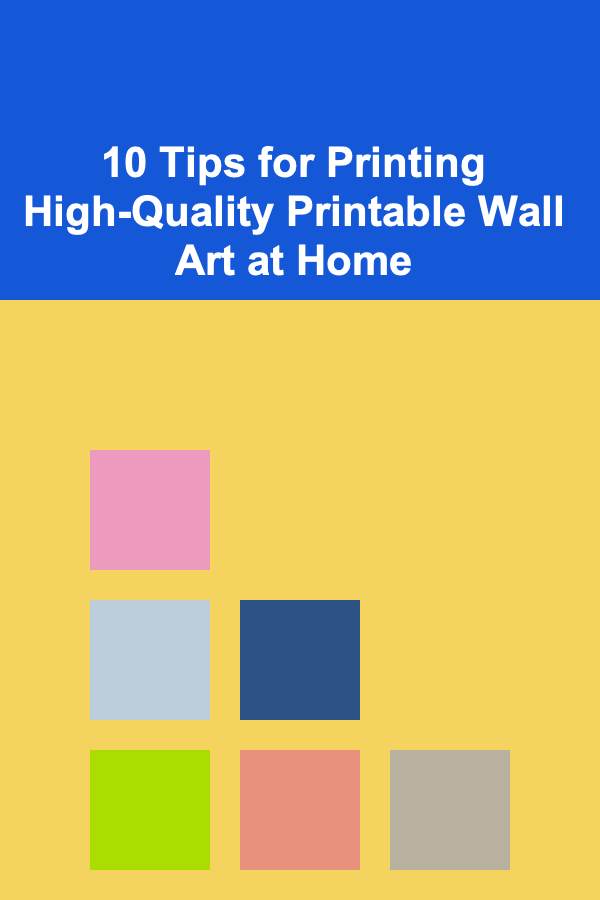
10 Tips for Printing High-Quality Printable Wall Art at Home
ebook include PDF & Audio bundle (Micro Guide)
$12.99$11.99
Limited Time Offer! Order within the next:

Creating printable wall art at home has become increasingly popular, thanks to the affordability, ease, and creativity it allows. Instead of spending money on expensive art prints from galleries or online stores, you can print your own high-quality art right from the comfort of your home. Whether you want to decorate a room with custom designs or print photographs for display, high-quality results are possible with the right approach and equipment. In this article, we'll go over 10 essential tips to help you print stunning wall art at home that's both professional and cost-effective.
Invest in a High-Quality Printer
One of the most important factors in ensuring your printed wall art looks professional is the printer itself. For the best results, you need a printer that can handle high-resolution prints and produce vivid, sharp colors.
- Inkjet Printers: Inkjet printers are typically the best choice for home art printing. They offer high-quality color reproduction and can handle a variety of paper types. Look for a printer with a high DPI (dots per inch), as a higher DPI ensures greater image resolution and detail.
- Printer Size: If you're printing large-format artwork, consider investing in a wide-format printer, which can print images larger than the standard letter size (8.5x11 inches). This allows you to create oversized prints, which are often more dramatic and impactful for wall decor.
- Photo Printers: If you're specifically interested in printing photos, look for a photo printer designed to produce professional-quality prints, such as those used by photographers.
An investment in a quality printer can make a significant difference in the overall outcome of your wall art.
Choose the Right Paper for Printing
The type of paper you use for printing is just as important as the printer itself. Different paper types produce different textures, finishes, and colors, so it's essential to select the right one based on your artistic vision.
- Matte Paper: Matte paper offers a non-reflective, smooth finish that's ideal for creating a more subtle and muted look. It works well for prints that need to be elegant and understated.
- Glossy Paper: If you want your prints to have a shiny finish and vibrant colors, opt for glossy paper. This type of paper enhances contrast and brightness, making it perfect for high-color images or photographs.
- Canvas Paper: If you want to achieve the textured look of a painting, canvas paper is a fantastic option. It gives your art a more painterly feel and is perfect for creating prints that mimic the look of traditional artworks.
- Watercolor Paper: For a more artistic and unique finish, watercolor paper gives your prints a rich, textured feel that works well with abstract or painted designs.
Experiment with different paper types to find the one that suits your style and the specific look you're going for.
Ensure Your Image Resolution Is High
Before printing, make sure your digital image is of high resolution. Resolution is key to achieving sharp, crisp prints without pixelation.
- Image DPI: The standard resolution for high-quality prints is 300 DPI (dots per inch). This ensures that the print has enough detail to look professional and clear, even when viewed up close.
- Avoid Low-Resolution Images: Avoid printing images that are low resolution or small in size. Enlarging a low-resolution image will cause it to lose clarity and look blurry. Always check the resolution of your image before printing, especially if you plan to enlarge it.
To check image resolution, simply open your image file on your computer and look at the image properties to make sure it's 300 DPI at the print size you intend to use.
Use the Right Color Settings
Color calibration plays a significant role in ensuring your prints match what you see on your screen. Different devices can display colors differently, and without proper color management, your print may look drastically different from the digital version.
- Monitor Calibration: Calibrate your monitor to ensure the colors on the screen are accurate. There are tools and software available that can help you calibrate your monitor's color settings so that the colors you see on the screen match those of your printer.
- Color Profiles: Use color profiles for your printer and paper type. Most high-quality printers come with ICC profiles (International Color Consortium profiles) for different paper types. Installing and using the correct profile will help achieve color accuracy, particularly for vibrant or subtle shades.
- Soft Proofing: Some design software, such as Adobe Photoshop or Lightroom, offer a soft proofing option that lets you simulate how colors will appear when printed. This feature can be helpful in adjusting the image before printing to avoid color discrepancies.
Proper color settings and calibration ensure your final print will reflect the true colors of your digital art or photographs.
Print a Test Image First
Before committing to printing your final piece of wall art, it's a good idea to do a test print. This allows you to check for any color issues, resolution problems, or unexpected results in the print.
- Test on Smaller Paper: Print a small section of your image or a scaled-down version on a piece of paper that's smaller than your intended size. This way, you can preview how the final print will look and make any necessary adjustments without wasting paper and ink.
- Check for Clarity: Look closely at the test print to check for clarity, resolution, and color accuracy. If the print doesn't look sharp or the colors are off, adjust your settings or make changes to the image before printing the full-sized version.
By printing a test version, you reduce the risk of costly mistakes when printing large pieces of wall art.
Optimize Print Settings
When printing your artwork, ensure that your printer settings are optimized for high-quality output. Many printers have preset modes for different types of prints.
- Choose the Highest Quality Setting: Most printers allow you to choose between draft, normal, or high-quality printing modes. Always select the high-quality option for printing wall art to ensure maximum detail and color richness.
- Adjust Paper Type in Settings: Make sure the printer settings match the paper type you're using. Most printers will ask you to choose the paper type before printing, and selecting the correct paper type will ensure better print quality.
- Print in Full-Color Mode: For full-color images, be sure to print in color mode rather than black-and-white or grayscale.
These small adjustments can have a big impact on the quality of your print.
Trim and Mount Your Prints for a Professional Look
After printing your artwork, trimming and mounting it properly can make a huge difference in its presentation.
- Use a Paper Cutter: Use a high-quality paper cutter or cutting mat to trim your artwork to the desired size. This ensures clean, straight edges without tearing the paper.
- Matting: Consider adding a mat around your print. Matting gives your print a professional, gallery-like appearance and helps it stand out on the wall. It also prevents the print from coming into direct contact with the glass, which can cause moisture damage over time.
- Frame It: For an even more polished look, frame your print using a high-quality frame that complements the design. You can find affordable frames in a variety of styles, or even have custom frames made for a unique touch.
Trimming and framing your print helps elevate it from a DIY project to a professional piece of art.
Consider the Printing Environment
The environment in which you print can affect the outcome of your work. Factors like humidity, temperature, and lighting can influence how your prints come out.
- Print in a Controlled Environment: Avoid printing in excessively humid or dry environments, as this can impact the paper and ink. A stable room temperature with minimal humidity is ideal for printing.
- Avoid Direct Light: Printing in a room with direct sunlight can cause colors to look washed out, so try to print in a dimly lit room or one with indirect light.
Printing in an optimal environment ensures that the paper and ink behave as expected, leading to a better result.
Maintain Your Printer Regularly
Regular maintenance of your printer can prevent common issues like clogged nozzles or poor color reproduction, ensuring the longevity and performance of your printer.
- Clean the Printer Heads: Over time, inkjet printers can develop clogged print heads. Most printers have a cleaning function that you can run to keep the nozzles clear.
- Use High-Quality Ink: Using high-quality ink and cartridges is essential for maintaining the print quality. Cheap or third-party inks may cause color inconsistencies and potentially damage your printer.
By maintaining your printer and keeping it clean, you'll ensure that it produces consistently high-quality prints.
Store and Display Your Prints Properly
Once your print is complete, it's important to store and display it in a way that preserves its quality over time.
- Store Prints Flat: If you're not framing your artwork immediately, store your prints flat in a dry place to prevent warping or damage.
- Avoid Direct Sunlight: Sunlight can fade colors over time, so display your prints in a place that's not directly exposed to sunlight.
- Protect Your Prints with Glass or Acrylic: When framing your prints, use UV-protective glass or acrylic to help preserve the colors and prevent fading.
Proper storage and display can help your wall art maintain its beauty for years to come.
Conclusion
Printing high-quality wall art at home is both a creative and rewarding process, and with the right tools, techniques, and attention to detail, you can produce professional-grade prints that rival those sold in galleries. By following these 10 tips, from selecting the right printer and paper to properly framing and displaying your prints, you'll be able to create stunning artwork for your home that reflects your personal style and artistic vision. With a little practice and patience, you'll soon be printing high-quality wall art that transforms your living space.
Reading More From Our Other Websites
- [Home Lighting 101] How to Use Ambient Lighting to Create Mood and Atmosphere in Every Room
- [Home Family Activity 101] How to Build a Creative DIY Puppet Show Stage and Characters from Recycled Materials
- [Personal Financial Planning 101] How to Reduce Financial Stress and Improve Your Mental Well-being
- [Organization Tip 101] How to Store Paints and Brushes for Kids' Projects
- [Home Budget Decorating 101] How to Design DIY Backsplash Ideas That Add Style to Your Kitchen
- [Trail Running Tip 101] How Nature's Beauty Fuels Your Best Trail Running Performances
- [Home Budget 101] How to Prepare Your Home Budget for a Pet Adoption: Beyond the Initial Costs
- [Personal Care Tips 101] How to Keep Your Hair and Nails Healthy
- [Personal Care Tips 101] How to Combine Teeth Whitening Strips with Other Whitening Products
- [Gardening 101] The Best Garden Books for Every Type of Gardener

How to Allocate Time for Learning and Growth
Read More
How to Make Your Rental Property Pet-Friendly Without Damaging It
Read More
How To Clean Your Carpets Naturally
Read More
Leveraging Social Media for Business Growth
Read More
10 Tips for Using Fabric and Textiles as Photo Props
Read More
10 Tips for Managing Gallery Staff and Volunteers
Read MoreOther Products

How to Allocate Time for Learning and Growth
Read More
How to Make Your Rental Property Pet-Friendly Without Damaging It
Read More
How To Clean Your Carpets Naturally
Read More
Leveraging Social Media for Business Growth
Read More
10 Tips for Using Fabric and Textiles as Photo Props
Read More